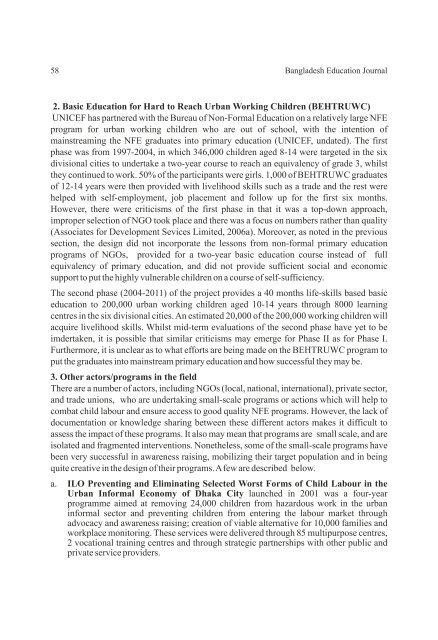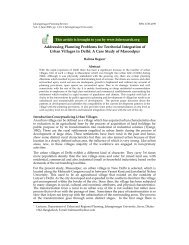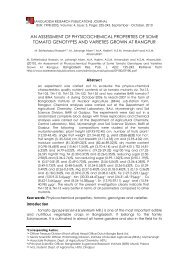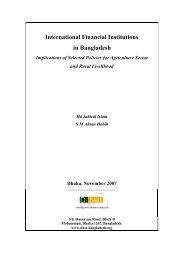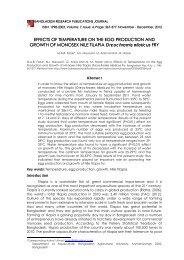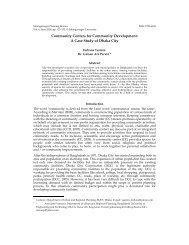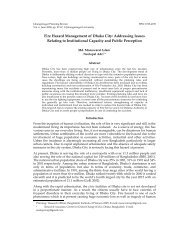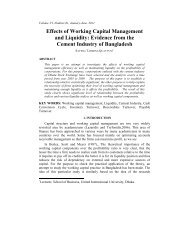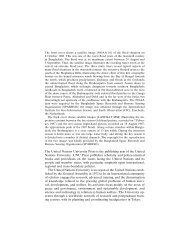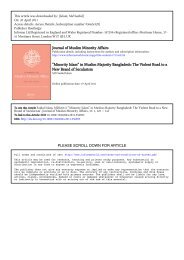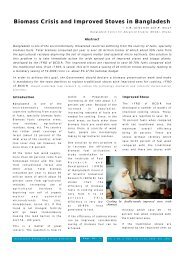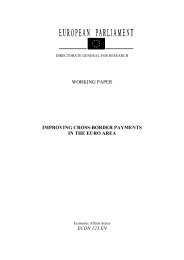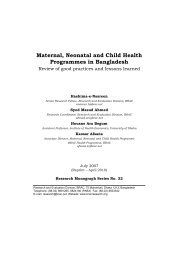Child Labour and Education in Bangladesh - Bangladesh Online ...
Child Labour and Education in Bangladesh - Bangladesh Online ...
Child Labour and Education in Bangladesh - Bangladesh Online ...
Create successful ePaper yourself
Turn your PDF publications into a flip-book with our unique Google optimized e-Paper software.
58 <strong>Bangladesh</strong> <strong>Education</strong> Journal2. Basic <strong>Education</strong> for Hard to Reach Urban Work<strong>in</strong>g <strong>Child</strong>ren (BEHTRUWC)UNICEF has partnered with the Bureau of Non-Formal <strong>Education</strong> on a relatively large NFEprogram for urban work<strong>in</strong>g children who are out of school, with the <strong>in</strong>tention ofma<strong>in</strong>stream<strong>in</strong>g the NFE graduates <strong>in</strong>to primary education (UNICEF, undated). The firstphase was from 1997-2004, <strong>in</strong> which 346,000 children aged 8-14 were targeted <strong>in</strong> the sixdivisional cities to undertake a two-year course to reach an equivalency of grade 3, whilstthey cont<strong>in</strong>ued to work. 50% of the participants were girls. 1,000 of BEHTRUWC graduatesof 12-14 years were then provided with livelihood skills such as a trade <strong>and</strong> the rest werehelped with self-employment, job placement <strong>and</strong> follow up for the first six months.However, there were criticisms of the first phase <strong>in</strong> that it was a top-down approach,improper selection of NGO took place <strong>and</strong> there was a focus on numbers rather than quality(Associates for Development Sevices Limited, 2006a). Moreover, as noted <strong>in</strong> the previoussection, the design did not <strong>in</strong>corporate the lessons from non-formal primary educationprograms of NGOs, provided for a two-year basic education course <strong>in</strong>stead of fullequivalency of primary education, <strong>and</strong> did not provide sufficient social <strong>and</strong> economicsupport to put the highly vulnerable children on a course of self-sufficiency.The second phase (2004-2011) of the project provides a 40 months life-skills based basiceducation to 200,000 urban work<strong>in</strong>g children aged 10-14 years through 8000 learn<strong>in</strong>gcentres <strong>in</strong> the six divisional cities. An estimated 20,000 of the 200,000 work<strong>in</strong>g children willacquire livelihood skills. Whilst mid-term evaluations of the second phase have yet to beimdertaken, it is possible that similar criticisms may emerge for Phase II as for Phase I.Furthermore, it is unclear as to what efforts are be<strong>in</strong>g made on the BEHTRUWC program toput the graduates <strong>in</strong>to ma<strong>in</strong>stream primary education <strong>and</strong> how successful they may be.3. Other actors/programs <strong>in</strong> the fieldThere are a number of actors, <strong>in</strong>clud<strong>in</strong>g NGOs (local, national, <strong>in</strong>ternational), private sector,<strong>and</strong> trade unions, who are undertak<strong>in</strong>g small-scale programs or actions which will help tocombat child labour <strong>and</strong> ensure access to good quality NFE programs. However, the lack ofdocumentation or knowledge shar<strong>in</strong>g between these different actors makes it difficult toassess the impact of these programs. It also may mean that programs are small scale, <strong>and</strong> areisolated <strong>and</strong> fragmented <strong>in</strong>terventions. Nonetheless, some of the small-scale programs havebeen very successful <strong>in</strong> awareness rais<strong>in</strong>g, mobiliz<strong>in</strong>g their target population <strong>and</strong> <strong>in</strong> be<strong>in</strong>gquite creative <strong>in</strong> the design of their programs. A few are described below.a. ILO Prevent<strong>in</strong>g <strong>and</strong> Elim<strong>in</strong>at<strong>in</strong>g Selected Worst Forms of <strong>Child</strong> <strong>Labour</strong> <strong>in</strong> theUrban Informal Economy of Dhaka City launched <strong>in</strong> 2001 was a four-yearprogramme aimed at remov<strong>in</strong>g 24,000 children from hazardous work <strong>in</strong> the urban<strong>in</strong>formal sector <strong>and</strong> prevent<strong>in</strong>g children from enter<strong>in</strong>g the labour market throughadvocacy <strong>and</strong> awareness rais<strong>in</strong>g; creation of viable alternative for 10,000 families <strong>and</strong>workplace monitor<strong>in</strong>g. These services were delivered through 85 multipurpose centres,2 vocational tra<strong>in</strong><strong>in</strong>g centres <strong>and</strong> through strategic partnerships with other public <strong>and</strong>private service providers.


